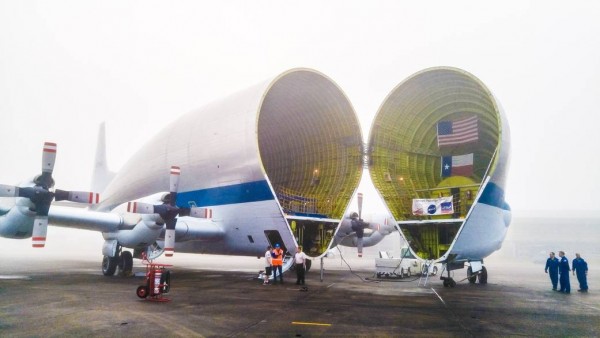By Ana Verayo, | February 02, 2016

NASA's Super Guppy aircraft readies to transport the Orion spacecraft pressure vessel.
The Orion capsule finally arrived at the Kennedy Space Center Monday morning from the NASA's Michoud Assembly Facility in New Orleans where this NASA spacecraft has been in development to bring the first humans to Mars.
Like Us on Facebook
From New Orleans to Cape Canaveral, NASA relied on the help of the Super Guppy aircraft to transport the Orion, which is an odd shaped airplane. The Super Guppy measures 25 feet tall, 25 feet wide and 111 feet long, where this jumbo plane can carry 26 tons of cargo that are shipped to and from NASA. This special aircraft is also used to carry massive parts or components that will take too long or would even be impossible to transfer across the country by land or sea.
Since the Apollo program back in the 1960s, NASA has relied on the Super Guppy to carry parts of the Saturn V rocket from California to Florida. Back in those days, it can take weeks to months to transport rocket stages via sea through the Panama Canal.
To date, this jumbo aircraft also ships NASA's supersonic jets and even modules of the International Space Station. In 2013, the Super Guppy carried Orion's heat shield which is the largest one ever built and carried it out to Florida.
The Orion is still in the process of completion, where this is a crucial stage in transporting humans to Mars. NASA's Mars mission is slated to carry four astronauts on the Orion capsule where it will be launched by NASA's powerful rocket, the Space Launch System (SLS).
The first test flight of the Orion known as the Exploration Flight Test 1 brought the capsule some 3,600 miles beyond lower Earth orbit, some 15 times the distance of the International Space Station's orbit.
During this test flight, basic functions for a crewed mission to deep space were tested, making it the first human rated capsule to fly past lower Earth orbit in more than 40 years.
Now, the Orion is now housed under the Kennedy Space Center where another series of tests will be carried out for its pressure vessel, to analyze its primary structural performance.
In 2018, the Orion will be launched for its second test flight and its first one on the SLS rocket after being outfitted with the necessary systems. The first manned mission for Orion is scheduled for 2023, where NASA hopes to send the first humans to Mars by the 2030s.
-
Use of Coronavirus Pandemic Drones Raises Privacy Concerns: Drones Spread Fear, Local Officials Say

-
Coronavirus Hampers The Delivery Of Lockheed Martin F-35 Stealth Fighters For 2020

-
Instagram Speeds Up Plans to Add Account Memorialization Feature Due to COVID-19 Deaths

-
NASA: Perseverance Plans to Bring 'Mars Rock' to Earth in 2031

-
600 Dead And 3,000 In The Hospital as Iranians Believed Drinking High-Concentrations of Alcohol Can Cure The Coronavirus

-
600 Dead And 3,000 In The Hospital as Iranians Believed Drinking High-Concentrations of Alcohol Can Cure The Coronavirus

-
COVID-19: Doctors, Nurses Use Virtual Reality to Learn New Skills in Treating Coronavirus Patients







